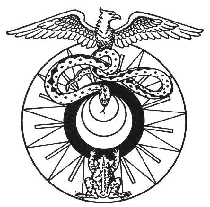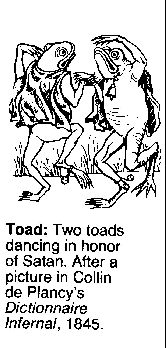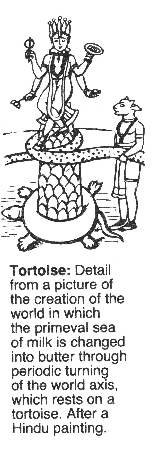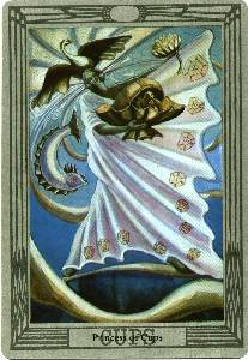Dancing Toads and Tortoise Creation
| By: Carl Teichrib; ©2002 |
| Folklore says that if you handle a toad with your bare hands, you’ll get warts. A silly superstitious belief, but there is more to the lowly toad than just “old wives tales.” The toad, as a symbol is found in many different religions and cultures throughout the world. Carl Teichrib explains. |
- Symbols are keyholes to doors in the walls of space, and through them man peers into Eternity. —Manly P. Hall, Lectures on Ancient Philosophy, p.357.
- Symbolical instruction is recommended by the constant and uniform usage of antiquity; and it has retained its influence throughout all ages, as a system of mysterious communication. —Albert Pike, Morals and Dogmas, p.372.
We see symbols every day. In the US, the one dollar bill is laced with esoteric markings. Symbols, both Christian and pagan, can be seen in stained glass church windows, cathedrals, and temples. Monuments across the continent act as symbols in and of themselves, and often have further symbols inscribed upon them. Symbols, be they benign or based in occult lore, are inescapable.
A simply way of explaining what symbols are would be thus; symbols are a tangible visible language conveying a message or meaning. In the occult world, those who are trained to “understand” these messages recognize that certain forces are at work in the world—forces which are spiritual in nature. Furthermore, in this world of esoteric learning, symbols hold the key to the secret doctrines and teachings of the ages. These doctrines are steeped in the philosophies of pagan mystery religions and secret societies, forming a spiritual “alternative” to the Biblical worldview; fully equipped with alternative histories, alternative ways of salvation, alternative gods, and alternative realities.
Understanding this greatly amplifies the words of Proverbs 14:12, “There is a way that seems right to a man, but in the end it leads to death.”
Manly P. Hall, one of the most influential occultists of the last century, wrote this of symbols, “They are centers of a mighty force, figures pregnant with an awful power…” (Lectures on Ancient Philosophy, p. 356)
Dancing Toads:

Folklore says that if you handle a toad with your bare hands, you’ll get warts. A silly superstitious belief, no doubt—but there is more to the lowly toad than just “old wives-tales,” the toad, as a symbol, can be found throughout the world in many different religions and cultures.
In the Penguin Dictionary of Symbols, the author writes concerning the toad and Chinese mythology,
The fear inspired by this creature of the twilight makes it generally regarded in the West as a symbol of ugliness and clumsiness. However, if one delves beneath the surface, one discovers that the toad carries all the significance deriving from that great symbolic chain which
links water with darkness, darkness with the Moon and the Moon with yin. Thus the Chinese regarded the toad as the Moon-goddess and believed that they could see a toad on the Moon.

In Egypt, the toad was associated with death and resurrection, and mummified toads have been found in Egyptian tombs. Other cultures, such as the Vietnamese, saw the toad as a herald of rain. Moreover, toad rain and fertility symbolism can be found in Mexico and in parts of Africa. Jack Tresidder, author of the reference work Dictionary of Symbols, explains that in certain parts of the world, the toad was “sometimes given the status of a cultural hero.”
Toads are also associated with Western witchcraft, being employed as symbols of poison, death, and darkness. Aleister Crowley—one of the most prolific occult adepts of the past one hundred years and a prominent figure in the modern revival of Western “magic” —employed toads and frogs in the conjuring of “familiar spirits” (Liber LXX—The Cross of a Frog). In Witchcraft, Magic and Alchemy, Grillot de Givry explains,
The toad is one of the shapes assumed by a demon when he sits upon a witch’s left shoulder. Thanks to two tiny horns borne on his forehead, a toad was recognizable as a demon, and witches took infinite care of him. They baptized their toads, dressed them in black velvet, put little bells on their paws, and made them dance.
Tortoise Creation:

A good friend of mine recently told me of his first day in university-level geography class. The professor briefly discussed evolution and Biblical creation. She then explained to the class her own beliefs. It turned out that she believed in a great tortoise who held the earth on its back, and that cosmic turtles were the foundations for the heavenly bodies. According to my friend, this professor went into elaborate detail about her beliefs, even providing evidences based on legends and mythologies to prove that her “theory” was valid.
Strange as this seems, it’s not surprising. The academic world has long ago embraced mystical ideas and concepts. The professor’s belief in a cosmic tortoise is not unique; rather, it’s a central tenant in the mythologies of Japan, China, and India. Herder Freiburg gives a detailed analysis of the Eastern-based tortoise creation views in The Herder Dictionary of Symbols.
The markings on its carapace were interpreted as the patterns of the structure of the cosmos. Sometimes the tortoise itself or its feet are depicted as the supports of the universe, the throne of heaven, the primal waters, or the islands of the immortals. In Mongolian myths a golden tortoise carries the central mountain of the universe. The arched carapace of the tortoise was sometimes regarded as a copy of the heavens, a sort of belly armor, raised above the disk of the earth previously believed to be flat. The tortoise itself was considered to be the mediator between heaven and earth, or a symbol of the entire universe.
Similar styled myths are also found in various North American native traditions. The Iroquois and other tribes held that a tortoise was foundational in the creation of earth. In Iroquois legend, a muskrat covered the shell of a turtle with mud from the bottom of the primal ocean. This mud and turtle became an island, and eventually grew into the earth as we know it today.
The tortoise is also found in the Golden Dawn Tarot. The tarot is a form of divination based on a series of cards steeped in occult lore. The Golden Dawn Tarot—based on the occult “wisdom” of the Hermetic Order of the Golden Dawn (where Aleister Crowley first began his magical work, see The Confessions of Aleister Crowley, p. 16) —has a tortoise in the card known as the Princess of Cups. This symbol represents wisdom and is associated with esoteric knowledge.
Sadly, throughout man’s history, God’s creation has been turned into objects representing various occult philosophies. In contrast, we read in the Genesis account that God proclaimed his creation to be “good.” Man—acting in rebellion against the Creator of the Universe—has taken God’s handiwork and warped it to accommodate “doctrines of demons.
This is a vivid reminder that we need to be spiritually grounded on God’s Holy Word. As the world turns to myths and occult lore for its guidance, we must offer a counter ideology based in God’s truth, mercy, and forgiveness. We live in the Age of Deception—be on your guard.
(Carl Teichrib is a researcher on globalization and the occult. He currently resides in Canada. You can reach him by emailing [email protected].)








[…] Dancing Toads and Tortoise Creation By: Carl Teichrib […]
[…] Read Part 15 […]